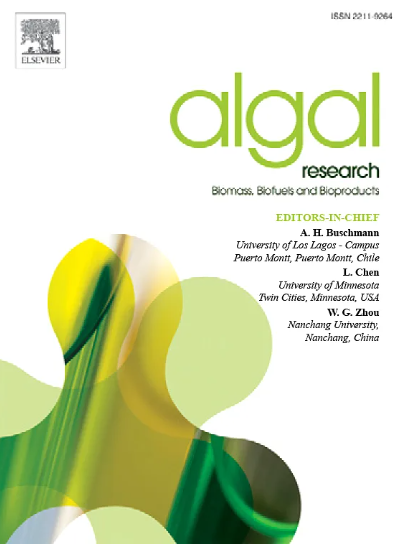How sticky is sticky? A note on gametophyte adherence of the macroalga Saccharina latissima (Phaeophyceae)
IF 4.5
2区 生物学
Q1 BIOTECHNOLOGY & APPLIED MICROBIOLOGY
Algal Research-Biomass Biofuels and Bioproducts
Pub Date : 2025-06-10
DOI:10.1016/j.algal.2025.104138
引用次数: 0
Abstract
Temperate marine systems are ideal environments for expanding global seaweed aquaculture, yet high costs, particularly from macroalgal nursery facilities, have become a limiting factor for industry development. Recent research has explored the use of binder-seeding, whereby juvenile kelp life stages are seeded directly onto rope using adhesive solutions and deployed directly at sea. This method is used to reduce our reliance on nursery facilities and reduce aquaculture costs. While binder-seeding has shown mixed results, a more simplistic approach by Klaus Lüning has received less attention. Klaus Lüning (1979) commented that kelp gametophytes were naturally ‘sticky’ and attach to substrata within ‘a short time’, potentially highlighting a natural and more cost-effective seeding technique. Here, we explored the natural adherence of Saccharina latissima gametophytes to aquaculture twine. Cultures were sprayed onto twine and left to adhere for eight increasing time periods, before being submerged in seawater and measured after 10 weeks of growth. Gametophytes were found to adhere and grow successfully on twine after immediate submergence in seawater, however significant differences in sporophyte lengths and density after 10 weeks growth were observed among time treatments. Sporophyte lengths and densities were found to be highest when the culture was left to adhere for 30 min prior to submergence in seawater, potentially highlighting a time-sensitive sweet spot for natural gametophyte seeding. Further, we confirm that Lüning's observation of kelp gametophytes sticking to substrata after a ‘short time’ was in fact ‘immediate’, thereby shorter than previously thought.
粘有多粘?大藻糖藻(phaeophyaceae)配子体粘附性的研究
温带海洋系统是扩大全球海藻养殖的理想环境,但高昂的成本,特别是大型海藻苗圃设施的高昂成本,已成为行业发展的限制因素。最近的研究探索了粘合剂播种的使用,即用粘合剂将幼嫩的海带直接播种到绳索上,并直接在海上部署。采用这种方法可以减少我们对苗圃设施的依赖,降低养殖成本。尽管粘合剂播种的效果喜忧参半,但Klaus l ning提出的一种更简单的方法受到的关注较少。Klaus l ning(1979)评论说,海带配子体具有天然的“粘性”,并在“短时间”内附着在基质上,这可能突出了一种自然且更具成本效益的播种技术。本研究探讨了甘蔗配子体对水产养殖麻绳的自然粘附。将培养物喷洒在麻绳上,让其附着8个时间,然后将其浸入海水中,在生长10周后进行测量。在海水中浸泡后,配子体在麻绳上成功附着生长,但在生长10周后,不同时间处理的孢子体长度和密度存在显著差异。孢子体的长度和密度在培养液浸泡30分钟后达到最高,这可能是自然配子体播种的时间敏感最佳点。此外,我们证实l ning观察到的海带配子体在“短时间”后附着在基质上的现象实际上是“立即”的,因此比之前认为的要短。
本文章由计算机程序翻译,如有差异,请以英文原文为准。
求助全文
约1分钟内获得全文
求助全文
来源期刊

Algal Research-Biomass Biofuels and Bioproducts
BIOTECHNOLOGY & APPLIED MICROBIOLOGY-
CiteScore
9.40
自引率
7.80%
发文量
332
期刊介绍:
Algal Research is an international phycology journal covering all areas of emerging technologies in algae biology, biomass production, cultivation, harvesting, extraction, bioproducts, biorefinery, engineering, and econometrics. Algae is defined to include cyanobacteria, microalgae, and protists and symbionts of interest in biotechnology. The journal publishes original research and reviews for the following scope: algal biology, including but not exclusive to: phylogeny, biodiversity, molecular traits, metabolic regulation, and genetic engineering, algal cultivation, e.g. phototrophic systems, heterotrophic systems, and mixotrophic systems, algal harvesting and extraction systems, biotechnology to convert algal biomass and components into biofuels and bioproducts, e.g., nutraceuticals, pharmaceuticals, animal feed, plastics, etc. algal products and their economic assessment
 求助内容:
求助内容: 应助结果提醒方式:
应助结果提醒方式:


